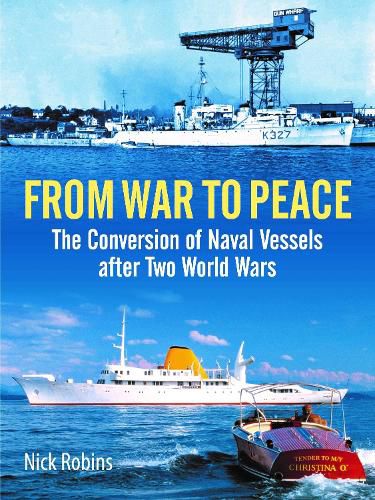From War to Peace: The Conversion of Naval Vessels After Two World Wars
Nick Robins

From War to Peace: The Conversion of Naval Vessels After Two World Wars
Nick Robins
From War to Peace tells the story of the adaptation from White Ensign to Red Ensign, and to flags of other nations, of the numerous classes of naval ships mainly built during the two world wars and surplus to requirements with the advent of peace. It also describes ships sourced from the United States Navy and elsewhere that were converted for commercial use. The most successful classes to transfer to the merchant service were the Hunt-class minesweepers of the Great War, Landing Craft, Tank, the salvage tugs of World War Two, and the wooden-hulled Fairmile launches which became familiar at seaside resorts in the 1950s and ‘60s; and, of course, the MFV classes that helped the fishing industry in the postwar years. The story includes the successful commercial conversions of many of the Flower and Castle Class corvettes and River Class frigates, notably the 1954 conversion of HMCS Stormont to a luxury yacht for the Greek shipping magnate Onassis. It describes why HMS Charybdis became a passenger liner in the Great War, and how HMS Albatross nearly became a luxury liner after World War Two, but in fact was transformed into a very unpopular emigrant ship and ended her days as a floating casino based at Cape Town. The author reveals the military antecedents of numerous commercial vessels that many would have thought were built especially for the service that they later maintained, and it illustrates just how many Royal Navy vessels ended up in private ownership. And the question is asked: if the military had not built so many ships that were eminently suitable for commercial adaptation, would the technical development of merchant shipping have progressed at a faster rate than it did? The answer is a definite 'no’, and is illustrated in several ways. It was former naval vessels that promoted the early development of the Ro-Ro ferry; former naval ships introduced numerous design innovations, for example, the raised foredeck common for so many years on salvage tugs, and, above all, stripped of their military hardware, ex naval ships provided opportunities for modest investment where otherwise there would have been none. Copiously illustrated throughout, the book tells a fascinating story of invention and ingenious ship conversion, and of pragmatic adaptation in the financially stringent years after two world wars. AUTHOR: Nick Robins, a geologist by profession, is acknowledged for setting maritime history within the bigger social and political picture. His books describe the evolution of a variety of ship types ranging from tugs and tenders to excursion steamers and cargo vessels. His last book, The Coming of the Comet, was published by Seaforth in 2012. 125 colour and b/w illustrations, maps
This item is not currently in-stock. It can be ordered online and is expected to ship in approx 2 weeks
Our stock data is updated periodically, and availability may change throughout the day for in-demand items. Please call the relevant shop for the most current stock information. Prices are subject to change without notice.
Sign in or become a Readings Member to add this title to a wishlist.


